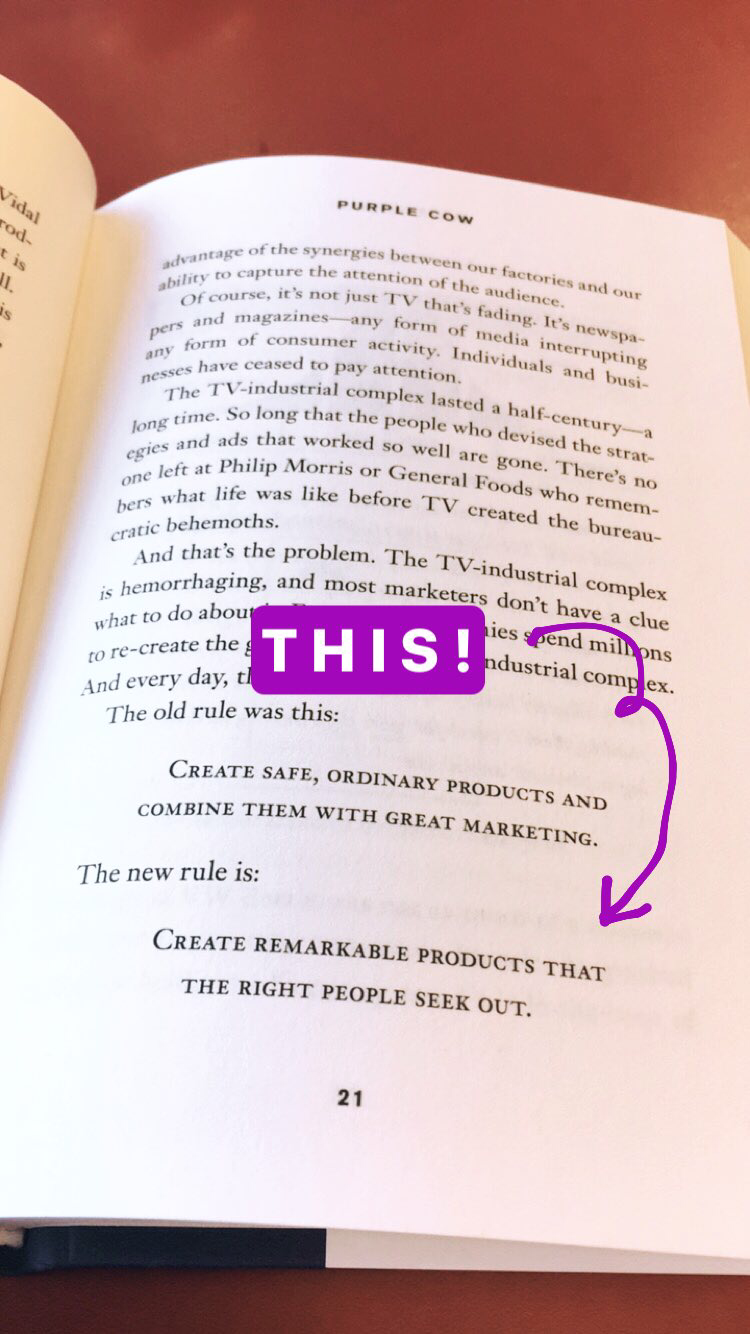

I just finished up reading the wonderful book Purple Cow by Seth Godin. No, this isn’t a children’s fairytale. It’s a very dense and crazy insightful book on marketing.
What is a purple cow?
This quote from the book below explains it perfectly.
“When my family and I were driving through France a few years ago we were enchanted by the hundreds of storybook cows grazing on the picturesque pastors right next to the highway. Then, within 20 minutes, we started ignoring the cows. The new cows were just like the old cows, and what once was amazing was now common. Worse than common. It was boring. Cows, after you’ve seen them for a while, are boring. They may be perfect cows, attractive cows, cows with great personalities, cows lit by beautiful light, but they’re still boring. A purple cow though. Now THAT would be interesting.”
I highly suggest reading it for yourself, but to offer you a preview, I’m sharing my top 4 takeaways below!
1. Create products that the RIGHT people seek out.


The products that work for anyone and everyone are all taken. There are too many choices available, and everyone is already satisfied. The real win is when you can target a niche instead of a huge market. Design products and services that appeal to a specific market and are perhaps misunderstood or unwanted by everyone else.
2. Build products and services that are “too” something.
Vanilla is the compromise ice-cream flavor. It’s boring, but it’s safe. Rarely do you find someone who doesn’t like vanilla ice-cream. But, you can find plenty of people who don’t like habanero pecan ice-cream. Maybe they’re allergic to nuts, sensitive to spice, or just uninterested in trying a strange ice-cream flavor. But… vanilla will work. The problem? You can’t build a fast growing company around vanilla. In almost every market, the boring slot is filled. The solution? Be “too something”. Growth comes to products and services that are “too something” for some people, but JUST RIGHT for the right people.
So, how can your product or service be “too” something? Here are a couple of ideas: Create products/service that annoy, offend, don’t appeal, are too expensive, too cheap, too heavy, too complicated, and too simple for some people.
As someone who is always bored by vanilla ice-cream, this idea really resonated with me. As a kid, the employees at our local frozen custard shop were always grossed out by my seemingly “too strange” custom custard order: chocolate custard with pecans, bananas, and cookie dough. It’s not for everyone, but it definitely appeals to some people.


3. Are your products/services remarkable or very good?
The opposite of remarkable is “very good” - not “bad”, not “mediocre.” Godin points out that many people don’t strive to create truly remarkable products because they believe that the opposite of remarkable would be a failure. If you travel on an airline and get there safely, you don’t go around telling everyone “You won’t believe it, my plane took me to the destination!” You expected to get there. The airline simply met your expectation. This is “very good.” Very good is an everyday occurrence and hardly worth mentioning. However, if the experience and service were remarkable, THAT is something you will share. Remarkable ideas are those worth telling people about. Are you creating very good stuff? OR, stuff worth telling people about?
4. Designers are fundamental to marketing.
In today’s market, the marketing must be built into the product or service itself, not slapped on as a last-minute add-on. Godin says that the people who have real influence on the success of the product as those who sit at the table when the original seeds for a project as being sown.
"If you are a marketer who doesn't know how to invent, design, influence, adapt, and ultimately discard products, then you're no longer a marketer. You're deadwood.”
Of course, as a designer, I found all of this super interesting. And as someone who does digital marketing, I found all of this to be so TRUE. When your marketing isn’t working often times the best solution is to change the product, not the marketing.
I really enjoyed reading Purple Cow. It’s engaging, not too long, and the many case studies provide valuable examples of exactly how all of this can be done. I highly recommend this book to anyone who works in marketing, design, or simply who owns a business!
Did you read the book? What were your biggest takeaways?

























